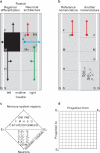The neuron classification problem
- PMID: 17582506
- PMCID: PMC2150566
- DOI: 10.1016/j.brainresrev.2007.05.005
The neuron classification problem
Abstract
A systematic account of neuron cell types is a basic prerequisite for determining the vertebrate nervous system global wiring diagram. With comprehensive lineage and phylogenetic information unavailable, a general ontology based on structure-function taxonomy is proposed and implemented in a knowledge management system, and a prototype analysis of select regions (including retina, cerebellum, and hypothalamus) presented. The supporting Brain Architecture Knowledge Management System (BAMS) Neuron ontology is online and its user interface allows queries about terms and their definitions, classification criteria based on the original literature and "Petilla Convention" guidelines, hierarchies, and relations-with annotations documenting each ontology entry. Combined with three BAMS modules for neural regions, connections between regions and neuron types, and molecules, the Neuron ontology provides a general framework for physical descriptions and computational modeling of neural systems. The knowledge management system interacts with other web resources, is accessible in both XML and RDF/OWL, is extendible to the whole body, and awaits large-scale data population requiring community participation for timely implementation.
Figures




References
-
- Amthor FR, Takahashi ES, Oyster CW. Morphologies of rabbit retinal ganglion cells with concentric receptive fields. J. Comp. Neurol. 1989;280:72–96. - PubMed
-
- Ashburner M, Lewis S. On ontologies for biologists: the Gene Ontology-untangling the web. Novartis Found. Symp. 2002;247:66–80. - PubMed
-
- Badea TM, Nathans J. Quantitative analysis of neuronal morphologies in the mouse retina visualized by a using a genetically directed reporter. J. Comp. Neurol. 2004;480:331–351. - PubMed
-
- Bailey KD. Typologies and Taxonomies: An Introduction to Classification Techniques. In Sage University Paper series on Quantitative Applications in the Social Sciences. Thousand Oaks; CA: 1994. pp. 7–102.
Publication types
MeSH terms
Grants and funding
LinkOut - more resources
Full Text Sources

